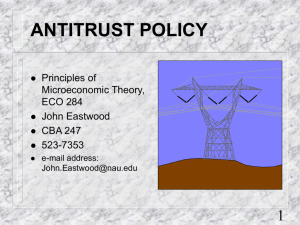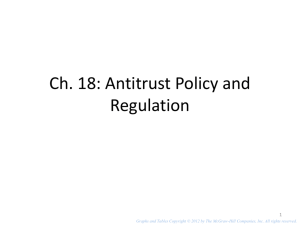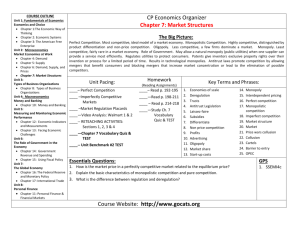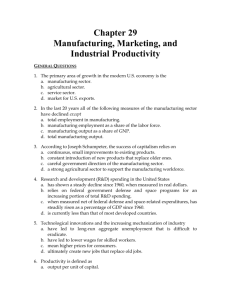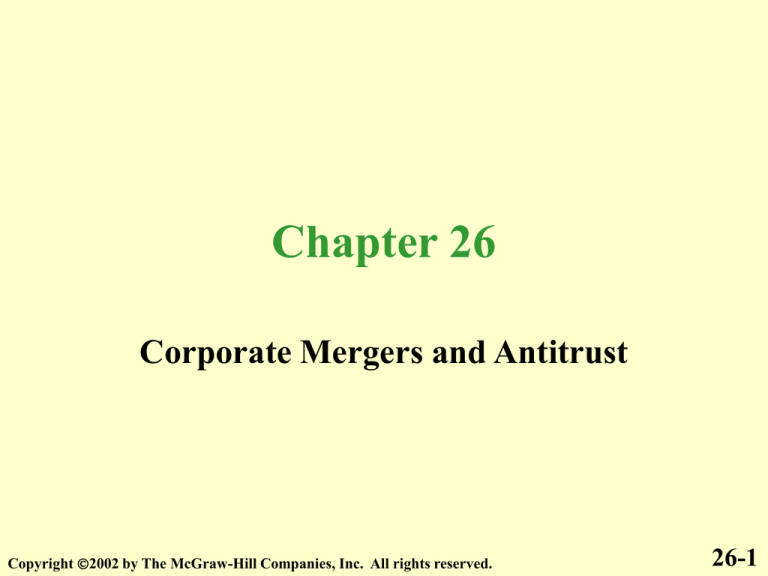
Chapter 26
Corporate Mergers and Antitrust
Copyright 2002 by The McGraw-Hill Companies, Inc. All rights reserved.
26-1
Chapter Objectives
•
•
•
•
•
•
•
The explanation of antitrust
Major antitrust laws
Modern antitrust
Types of mergers
The effectiveness of antitrust
The trend toward bigness
The Microsoft case
Copyright 2002 by The McGraw-Hill Companies, Inc. All rights reserved.
26-2
A Historical Perspective on
Corporate Concentration
• The history of the American economy
since the Civil War has been one of
growing corporate concentration
– Like tides, this concentration has had its
ebbs and flows
• During the last century and a quarter, a
few hundred companies came to
dominate our economy
Copyright 2002 by The McGraw-Hill Companies, Inc. All rights reserved.
26-3
Antitrust
• The political background
– During the 19th century the federal
government rarely intervened in the
economy
– There were, however, two major forms of
intervention, both of which were key issues
in the events leading up to the Civil War
• high protective tariffs
• the transcontinental railroad
Copyright 2002 by The McGraw-Hill Companies, Inc. All rights reserved.
26-4
The Political Background
• At various times the government passed a high
protective tariff that made imports more
expensive and greatly aided northern
manufacturers
– This forced the south to pay much higher prices for
the foreign goods they needed
– The transcontinental railroad, was built with
tremendous amounts of federal aid and it completely
bypassed the south
• Both policies were benevolent to big business,
so few protests were raised about government
intervention in the economy
Copyright 2002 by The McGraw-Hill Companies, Inc. All rights reserved.
26-5
The Political Background
• The late 19th century was the era of the
“trust”
• Trusts were cartels that set prices and
allocated sales among their member firms
– The most blatant were in oil and sugar
– Others were in meat packing, cottonseed and
linseed oil, lead, leather, whiskey, tobacco,
electrical tools, coal, steel, and the railroads
Copyright 2002 by The McGraw-Hill Companies, Inc. All rights reserved.
26-6
The Political Background
• Typical attitudes of the trust
– The great financier J. P. Organ proclaimed,
“I owe the public nothing”
– Railroad tycoon Billy Vanderbilt said, “The
public be dammed, I am working for my
stockholders”
Copyright 2002 by The McGraw-Hill Companies, Inc. All rights reserved.
26-7
The Sherman Antitrust Act
• In 1890 congress passed the Sherman Antirust
Act to curb the trust movement
– But the language of the law was left rather vague
• Finally, after years of preparation by the
Roosevelt (TR) and Taft administrations, suits
were brought against Standard Oil and
American Tobacco
– These companies were broken up by the court, not
because they were big but because they were bad
Copyright 2002 by The McGraw-Hill Companies, Inc. All rights reserved.
26-8
The Rule of Reason
• The Supreme Court’s decision breaking up
Standard Oil and the American Tobacco
Company was based on what they called its
“rule of reason”
– Bigness itself was not an offense as long as that
bigness was not used against rival firms
– This was in effect saying that the wolf not only had
to be big and bad, but he actually had to blow the
house down before he broke the law
Copyright 2002 by The McGraw-Hill Companies, Inc. All rights reserved.
26-9
The Clayton Antitrust Act
• The Clayton Act, passed in 1914,
prohibited practices that lessened
competition or tended to create a
monopoly
Copyright 2002 by The McGraw-Hill Companies, Inc. All rights reserved.
26-10
The Clayton Antitrust Act
• The Clayton Act prohibited five business
practices when their effect was to “substantially
lessen competition or tend to create a
monopoly”
–
–
–
–
–
Price discrimination
Interlocking stockholding
Interlocking directorates
Tying contracts
Exclusive dealings
• The Clayton act also expressly excused labor
unions from prosecution under the Sherman
Act
Copyright 2002 by The McGraw-Hill Companies, Inc. All rights reserved.
26-11
The Federal Trade Commission
Act (1914)
• The Federal Trade Commission (FTC) was set
up as a watchdog against the anticompetitive
practices outlawed by the Sherman and
Clayton acts
– The courts stripped most of its powers by the 1920s
– In 1938, the Wheeler-Lea Amendment gave the FTC
what has become its most important job: preventing
false and deceptive advertising
– In recent years the FTC has been playing a more
active role in approving or disapproving mergers
Copyright 2002 by The McGraw-Hill Companies, Inc. All rights reserved.
26-12
Modern Antitrust
• Antitrust enforcement evolved over the last
century, growing more stringent or lax,
depending on the presidential administration as
well as the political leaning of the Supreme
Court justices and the judges sitting in the
lower federal courts
• In Europe, enforcement varied from country to
country
– The formation of the 15-member European Union
has resulted in a more unified approach to antitrust,
especially since 1997
Copyright 2002 by The McGraw-Hill Companies, Inc. All rights reserved.
26-13
Partial Breakdown of the Rule of
Reason
• The membership of the Supreme Court
changed radically during the Roosevelt (FDR)
and Truman administrations
• In a landmark 1945 decision, the Court found
that the Aluminum Company of America
(Alcoa) which held 90% of the aluminum
market, was an illegal monopoly
• This decision eclipsed the “rule of reason”
– Alcoa lost because they were big, not because they
were both big and bad
Copyright 2002 by The McGraw-Hill Companies, Inc. All rights reserved.
26-14
The 60% Rule
• What has apparently evolved from past
antitrust decisions is what might be called the
“60% rule”
– “Should a firm have a share of at least 60% of the
relevant market and should that firm have behaved
badly toward its competitors, it would then be
subject to prosecution”
– Whether a firm would be prosecuted would depend
on the political and economic outlook of the current
administration and the outlook of the nine Supreme
Court justices
Copyright 2002 by The McGraw-Hill Companies, Inc. All rights reserved.
26-15
Four Landmark Cases
• Xerox
• AT&T
• IBM
• Microsoft
Copyright 2002 by The McGraw-Hill Companies, Inc. All rights reserved.
26-16
Four Landmark Cases
• Xerox
– This case hinged on whether the relevant
market was all paper copiers (less than 50%
of the market) or just plain paper copiers
(close to 100% of the market)
– Xerox agreed to license its patents to its
competitors
– By this time Japanese competitors were also
entering the American market causing
Xerox’s market share to fall below 50%
Copyright 2002 by The McGraw-Hill Companies, Inc. All rights reserved.
26-17
Four Landmark Cases
– AT&T
• AT&T was accused of having a monopoly
on local phone service (which it could
hardly contest) and of making it hard for
long-distance competitors to use its local
phone network
• AT&T was allowed to keep its longdistance service in exchange for giving up
its 22 local phone companies
• AT&T was also allowed to enter the
telecommunications-computer field
Copyright 2002 by The McGraw-Hill Companies, Inc. All rights reserved.
26-18
Four Landmark Cases
– IBM
• Originally initiated in 1969, this suit continued
for 13 years until the Reagan Justice Department
decided to drop it
• Between 1969 and 1982 IBM had about 70% of
the mainframe computer market
• But the word processor and minicomputer
markets had become an important segment of the
overall computer market during this period
• Thus the Justice Department reasoned that the
changing computer market made IBM’s
dominance in mainframes much less relevant
Copyright 2002 by The McGraw-Hill Companies, Inc. All rights reserved.
26-19
Four Landmark Cases
Microsoft
– This case has bounced around since 1995
– The Microsoft operating system runs on more than
90% of the 100 million PCs sold in the world each
year
• The Justice Department was concerned that the company
would use this virtual monopoly to force computer makers
to use software products it might create in the future,
further extending that monopoly
• Microsoft’s growing market power has enabled the
company to crush competitors, eliminating competition and
innovation, and probably harming consumers
• In April 2000, the court ruled against Microsoft
– Microsoft appealed its breakup, thus the breakup
order remains on hold
• The court’s restrictions on Microsoft’s conduct is not on
hold while its appeal proceeds
Copyright 2002 by The McGraw-Hill Companies, Inc. All rights reserved.
26-20
European Antitrust
Antitrust enforcement in the European
Union is conducted by the European
Commission, which not only approves or
prohibits mergers between Europe-based
corporations, but also plays an increasingly
important antitrust role with respect to other
corporations doing substantial business in
Europe
• While they have no power over mergers between
American firms, they do have the power to make
it difficult to do business in Europe
Copyright 2002 by The McGraw-Hill Companies, Inc. All rights reserved.
26-21
Types of Mergers
• Horizontal mergers
• Vertical mergers
• Conglomerate mergers
Copyright 2002 by The McGraw-Hill Companies, Inc. All rights reserved.
26-22
Horizontal Mergers
• Horizontal mergers
– A horizontal merger is the more or less
conventional merger of two firms in
the same industry
• Usually a larger firm swallows a smaller
one
• The legal problem with horizontal
mergers is that they appear to violate the
Sherman Antitrust Act by lessening
competition
Copyright 2002 by The McGraw-Hill Companies, Inc. All rights reserved.
26-23
Vertical Mergers
• Vertical mergers
– A vertical merger occurs when firms
that have been engaged in different
parts of an industrial process or in
manufacturing and selling join
together
– Some examples are
• Walt Disney’s acquisition of ABC
• The purchase of Time Inc. by Time
Warner communications (originally
known as Warner Brothers)
Copyright 2002 by The McGraw-Hill Companies, Inc. All rights reserved.
26-25
Conglomerate Mergers
• Conglomerate mergers
– A conglomerate merger occurs when two
companies in unrelated fields join together
– Conglomerating has several advantages
• It can provide ready-made markets for the goods and
services produce by various divisions
• The very diversity of the company is insurance against
economic adversity
• There are also tax advantages in conglomerating
– Conglomerating sometimes does not work
out well
• The companies do not mesh and inefficiencies often result
Copyright 2002 by The McGraw-Hill Companies, Inc. All rights reserved.
26-25
How Effective Is Antitrust?
• What do we want antitrust to do?
– If we want to create something approximating
perfect competition, antitrust has failed miserably
– If we would like to prevent further oligopolization of
American industry, it has been a qualified success
– Without antitrust things could have been a lot worse
• There would have been no legal means to curb any mergers
whatsoever
• Many firms hesitate to merge because they are fairly
certain the Justice Department would take legal action
– The whole focus of antitrust policy has been on
mergers and not on firms that generate their own
growth
Copyright 2002 by The McGraw-Hill Companies, Inc. All rights reserved.
26-26
The Trend Toward Bigness
• By and large American business is steadily becoming
more and more concentrated
• Mergers are part of a worldwide trend which shows no
signs of slowing down
• The distinction between American and foreign
companies is becoming blurred
• Multinational corporations are becoming more
common
• Because markets are global, few companies are
reaching the size and scale that should cause concern
about monopolies
• How does one nation, even the United States, enforce its
antitrust laws in the global market place?
Copyright 2002 by The McGraw-Hill Companies, Inc. All rights reserved.
26-27



